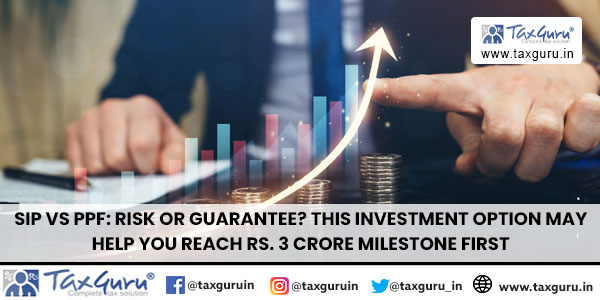SIP vs PPF: Risk or guarantee? This investment option may help you reach Rs. 3 crore milestone first
#AD
SIP vs PPF: Risk or guarantee? This investment option may help you reach Rs. 3 crore milestone first
When it comes to wealth creation, two popular investment options in India often come up for comparison: Systematic Investment Plans (SIP) and Public Provident Fund (PPF). Both are great ways to grow wealth over time, but they differ significantly in terms of risk, return, and the time it takes to reach financial milestones like Rs. 3 crore. Let’s break down the key differences between these two options and determine which is more likely to help you achieve the Rs. 3 crore goal faster.
Understanding SIP and PPF
SIP: The power of equity markets
If you want to invest a fixed amount in a particular mutual fund every month, it can be done through SIPs. SIPs are a popular choice because they allow you to invest in the stock market with smaller amounts over time. As equity funds have the potential for higher returns, SIPs have the power to generate significant wealth, particularly over long durations.

PPF: The safe and steady option
PPF is a government-backed, long-term savings scheme offering guaranteed returns and tax benefits. With a tenure of 15 years, PPF ensures safety but comes with relatively lower returns compared to equity investments. The interest rate is revised quarterly by the government, but it remains stable and relatively risk-free.
Risk factor: SIP vs PPF
SIP: A risk-reward proposition
While the potential for returns is high, especially over long periods, there is also the risk of market downturns affecting your investment. However, SIPs are ideal for long-term investors who can withstand market fluctuations and are seeking growth above inflation.
PPF: A guaranteed return
PPF, on the other hand, offers guaranteed returns with zero risk. The government guarantees the interest rate, though it fluctuates every quarter. The interest earned on PPF is tax-free, and the entire corpus at maturity is also tax-free.
While this makes PPF a safe investment, the returns are significantly lower compared to SIPs, especially in a high-inflation economy. The conservative nature of PPF is ideal for risk-averse investors or those nearing retirement who prioritise capital preservation over aggressive growth.
Time to reach Rs. 3 crore: SIP or PPF?
SIP: A faster route
Given the higher returns, SIPs are more likely to help you achieve the Rs. 3 crore milestone faster than a PPF.
Example: If you invest Rs. 50,000 per month in an equity mutual fund with an average return of 12% per annum, you would accumulate Rs. 3 crore in approximately 18-20 years. The power of compounding accelerates growth, and the higher return potential helps you achieve your goal faster.
PPF: A slower path
On the other hand, PPF with its guaranteed returns of 7.5% annually would take longer to reach the Rs. 3 crore mark. To accumulate Rs. 3 crore, it will take you approximately 38-40 years if you keep contributing Rs. 50,000 every month. Although PPF is safe and tax-effective, it requires significantly more time to reach substantial amounts when compared to SIPs.
Conclusion: SIP takes the lead
While PPF remains a strong choice for risk-averse investors seeking a safe and tax-efficient investment, SIPs emerge as the clear winner for those aiming to reach Rs. 3 crore faster. The higher return potential from equity markets, compounded over time, gives SIP an edge, especially for long-term wealth creation.




